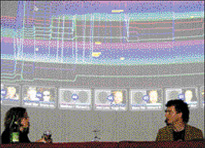Just as Friendster and MySpace can spur social interaction in the virtual world, Timelines, an RFID-enabled social-networking system, could bring together people at conferences and other events in the real world. That’s the hope of Someth;ng, a London-based interactive-media company that developed Timelines, an “automated scrapbook system” that documents people’s movements and interests, then shares that information among attendees, speakers and sponsors so they can network with each other during and after the event.
Earlier this year, Someth;ng tested Timelines at b.TWEEN 06, an interactive- media conference held in Bradford, England. Roughly 100 attendees who agreed to be tracked were given badges embedded with Wavetrend’s Ultra Long Range RFID tags. Wavetrend RFID interrogators, installed on-site, tracked their movements, such as which sessions they attended. Attendees could also click buttons on their badges, which activated an RF signal that was picked up by a nearby interrogator, to “bookmark” interesting points during presentations, which were all being recorded on audio.

The Timelines software collated the RFID data, and attendees could go to a conference Web site to find others who, for example, attended the same sessions or bookmarked the same areas of interest. The software also periodically matched up conference-goers based on their movements and bookmarks.
“Timelines doesn’t just automate the collection of this data in a reliable and noninvasive manner, but joins up the dots,” says Markus Quarta, one of seven associates who make up Someth;ng.
After the conference, Someth;ng posted the b.TWEEN database online, so attendees, speakers and sponsors could access it to explore their own and others’ conference experiences. Speakers, for instance, could see who attended their presentations, then e-mail attendees who had all bookmarked a certain part of the presentation, starting a post-conference dialogue and opening the door for future collaboration.
“Currently, conferences provide good pre- and during-event experiences, but little or no after-event support or networking tools,” says Quarta. “The Timelines system fits that space superbly, keeping the conference network open, annotated and exhaustively archived long after the last complimentary glass of fizzy has been drunk.”
Quarta says Timelines is continuing to evolve, and that Someth;ng is talking with several companies that are interested in using the networking system at their conferences.

